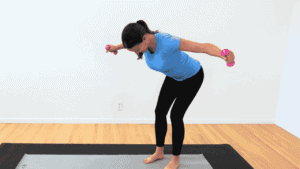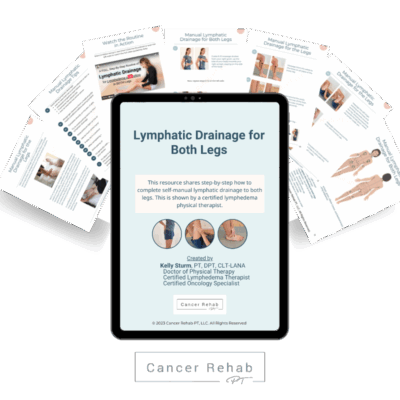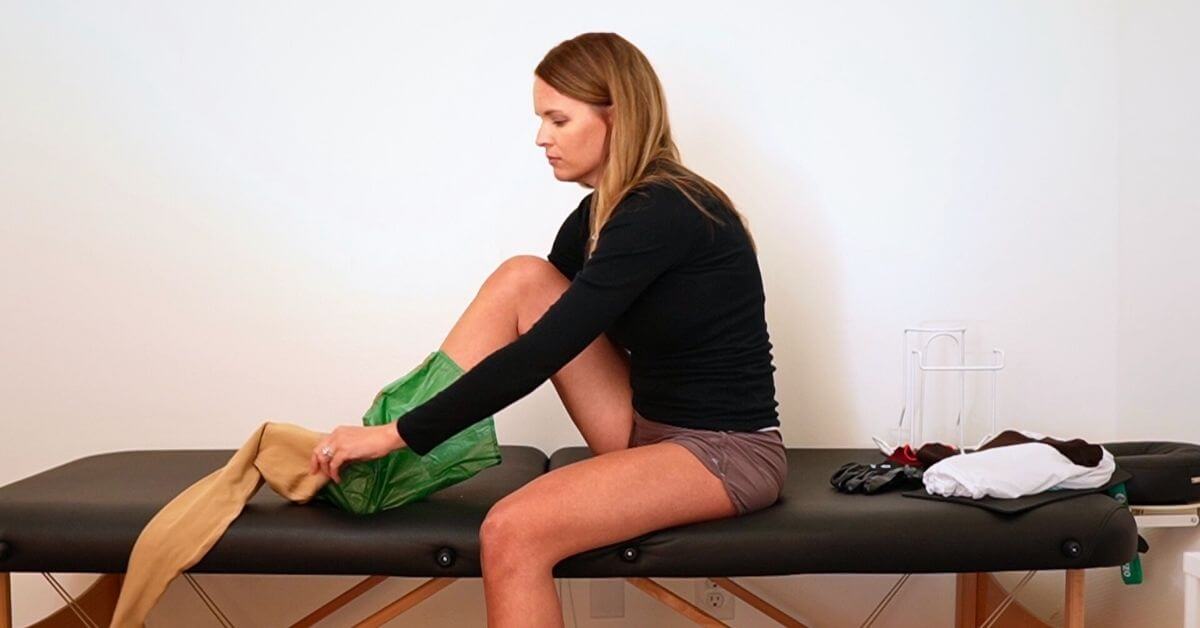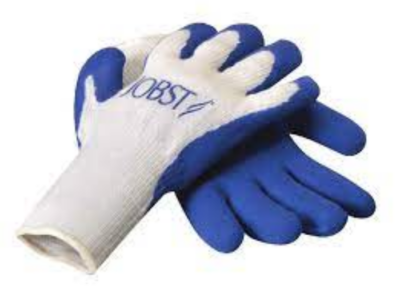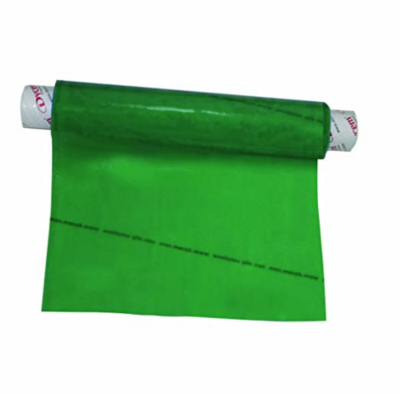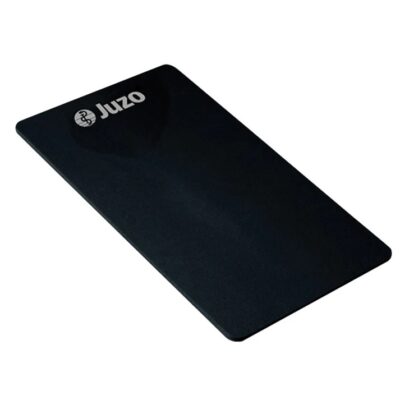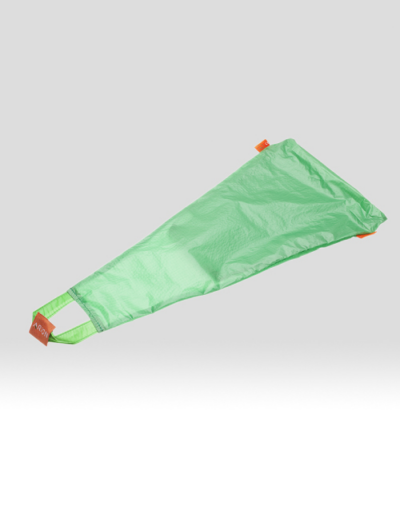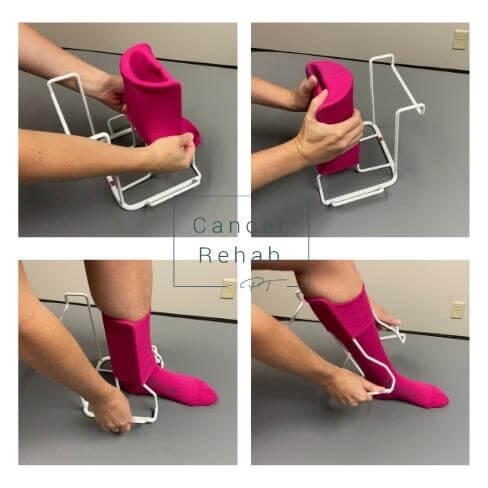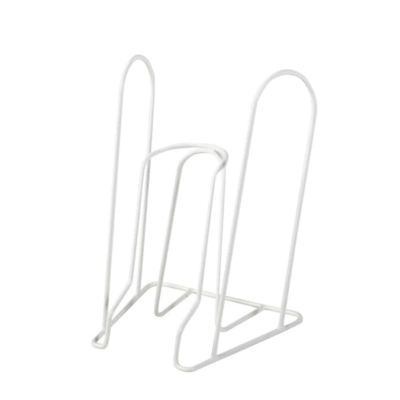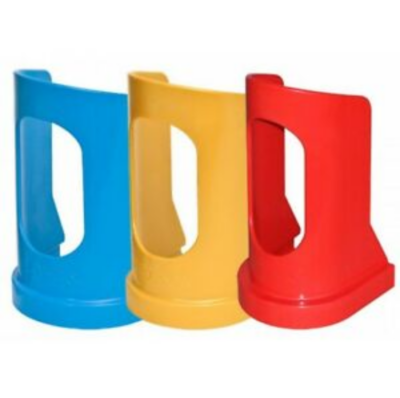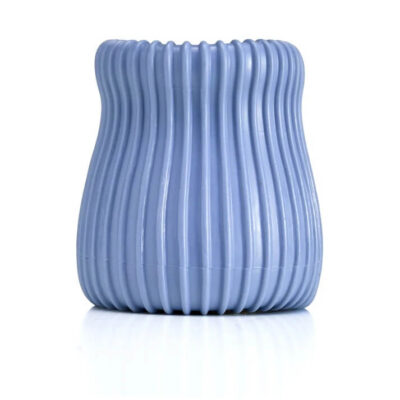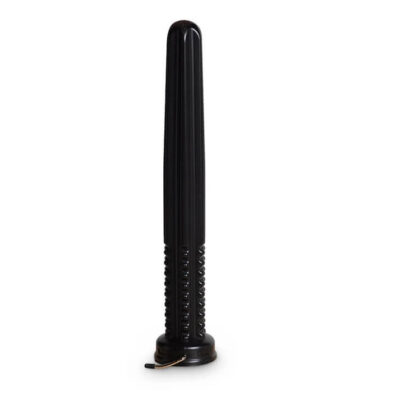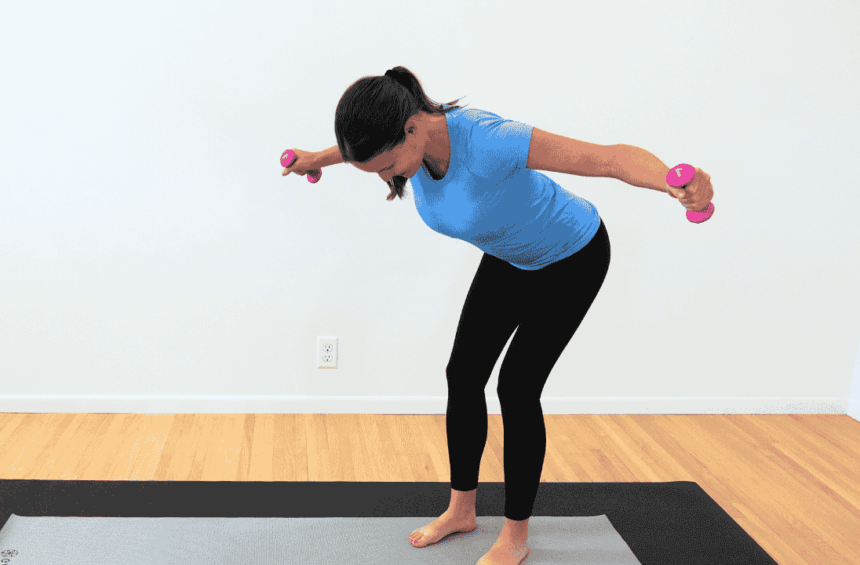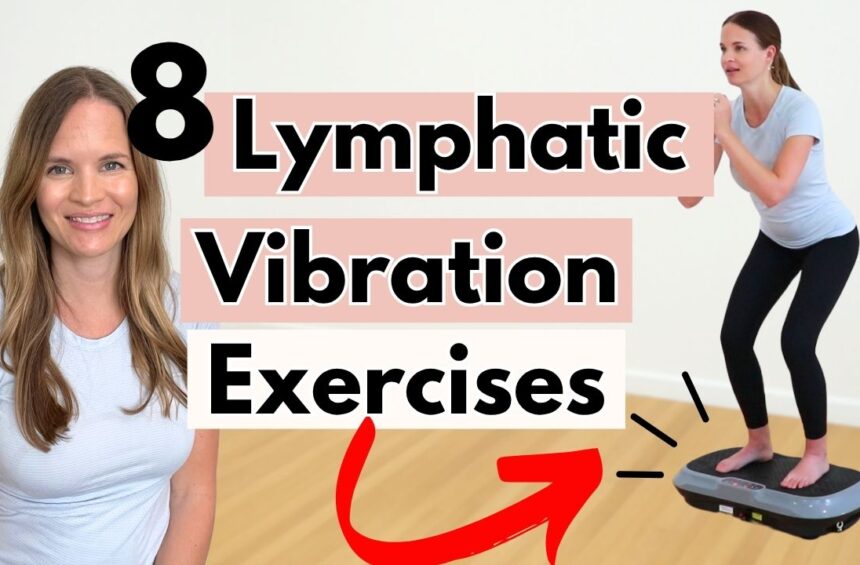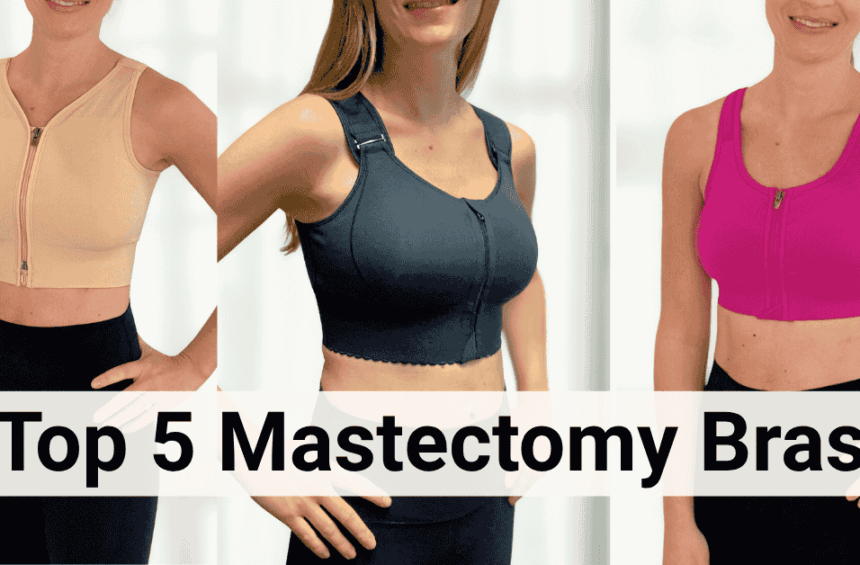After working with thousands of patients as a certified lymphedema therapist and physical therapist, I can tell you that one of the most common struggles I hear is: “I just can’t get these compression socks on!” If you’ve ever wrestled with compression stockings or even just gave up on them because they were so difficult – you aren’t alone.
The truth is, compression stockings are not made like regular socks and need to be put on in a different way than we are used to. With the right technique – and sometimes a helpful donning aid – what feels impossible can become manageable — even easy. Today, I want to share the exact easy way to put on compression socks that I teach my patients, plus the donning aids that have made the biggest difference for many.
Why Compression Socks Are So Hard to Put On
Unlike general socks, compression garments are designed to provide graduated pressure to improve circulation and reduce swelling. The compression stockings have different fabric, and if you just try to pull it on like a normal sock, it’s just going to stretch a lot which makes it really hard to get the foot and ankle piece on.
The other mistake I see people make is they’ll try to bunch up the sock like they would another sock, but when you try to pull it on, it’s too tight. If you have too many layers with these stockings it makes it really hard to open up, and that’s pretty challenging to get the sock on.
The compression level—measured in mmHg (millimeters of mercury)—determines how much pressure the garment provides. A 15-20 mmHg sock will feel much easier to put on than a 30-40 mmHg stocking. But regardless of the compression level, we still put compression socks on in a similar way.
Easy Way to Put On Compression Socks
Compression therapy is one of the most important ways to manage swelling. These are the helpful tips and simple steps I have used over years of working with people with lymphedema, elderly clients, and people with limited mobility. This easy way to put on compression socks works for knee-high, thigh-high, and even pantyhose garments.
Note: If this doesn’t seem realistic for you due to issues reaching your foot or bending over this way, then keep scrolling to find donning aids that can make everything a lot easier! I promise there are options available for you!
Step 1: Prepare Your Environment and Skin
- Sit on a bed or sturdy chair with good back support
- Make sure your skin is completely dry (garments stick to damp skin or lotion that hasn’t had time to fully air dry)
Step 2: Turn the Sock Inside Out (The Important Step!)
This is the most important step – what you want is as little layering as possible.
- Instead of bunching it up, reach into the heel portion of the sock
- Pinch at the heel
- And then pull it inside out
- Smooth out the heel part


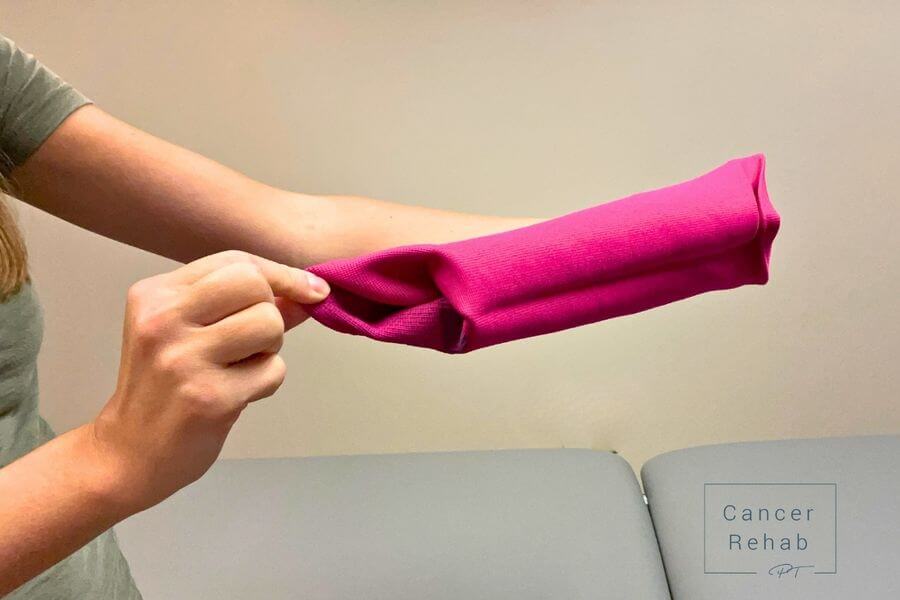
From there, I still have some stretch to open it up, and I’m going to put it on like a normal sock.
Step 3: Put Your Foot Into the Toe Area
- Slip your foot into the inside-out toe portion
- Pull it up towards the heel
- Make sure your heel is positioned correctly in the heel pocket
- Your toes should fit comfortably in the toe area
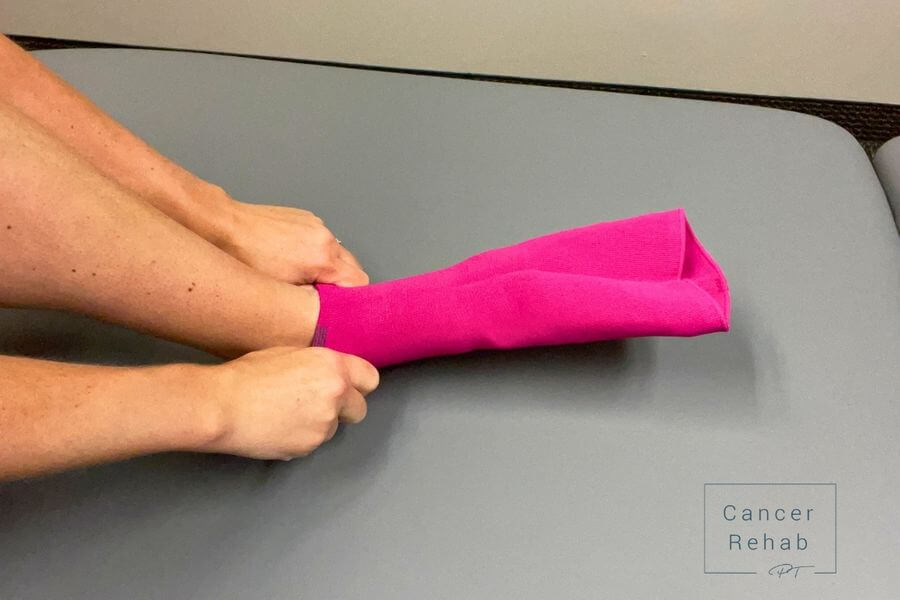
Step 4: Work the Sock Up Your Leg
From there you have two options. If you feel pretty confident with your strength, you can just pull it up the rest of the way. Or if it’s a little bit of a thicker sock or you struggle with the tightness, you can do it in two sections:
- Option 1 – All at once: If you have good hand strength, pull the entire sock up in one motion
- Option 2 – Two sections (my preferred method):
- First, I’ll just pull around where the toe area is and pull up
- Then I’ll pull that last piece the rest of the way separately
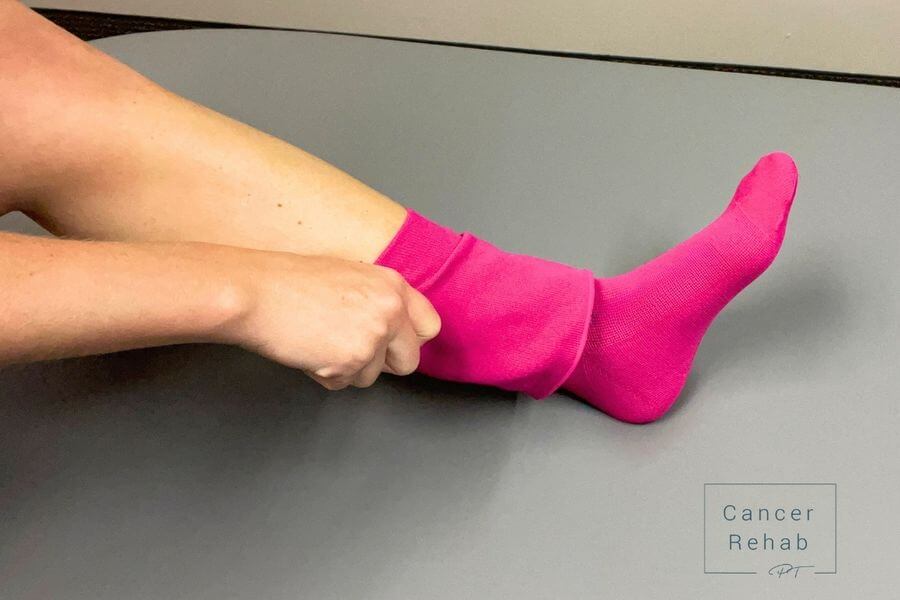
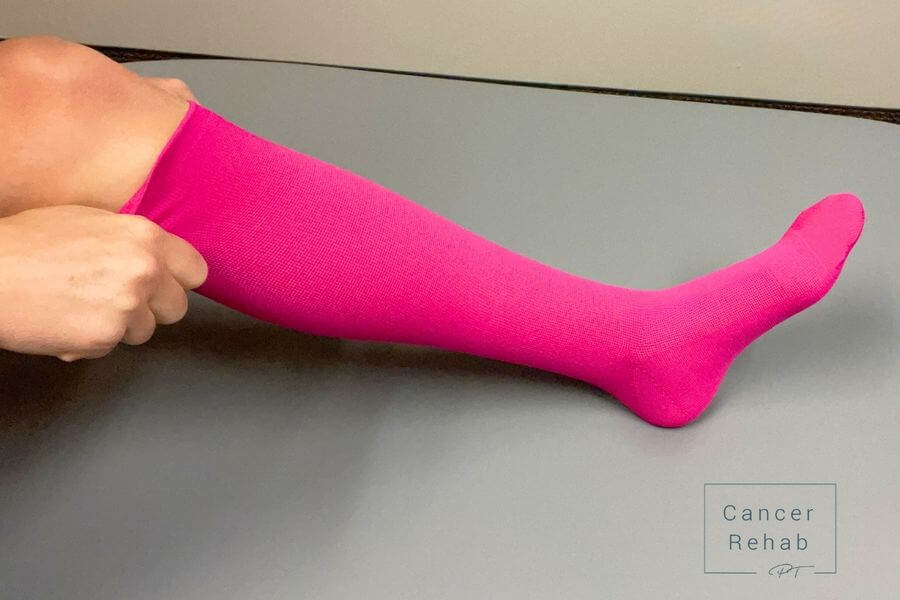
Step 5: Final Adjustments
From there I just want to go back – I might pull out the toe area so it’s not so tight there, make sure the heel area is in alignment, and make sure there’s no creases anywhere on the sock and that the fabric is smoothed out.
How to Put On Compression Stockings Thigh High: Additional Steps
If you’re wondering how to put on thigh-high garments, the process starts exactly the same way as knee-high socks, but requires a few additional pieces:
Extra Steps for Thigh-High Stockings:
Step 6: Continue Rolling Past the Lower Leg
- Once you’ve reached the knee using the method above, take a brief pause
- Make sure the stocking is free of creases and properly positioned before continuing
- Continue the gradual rolling motion up your thigh
- Work in even smaller sections (1-2 inches at a time) as the fabric gets tighter
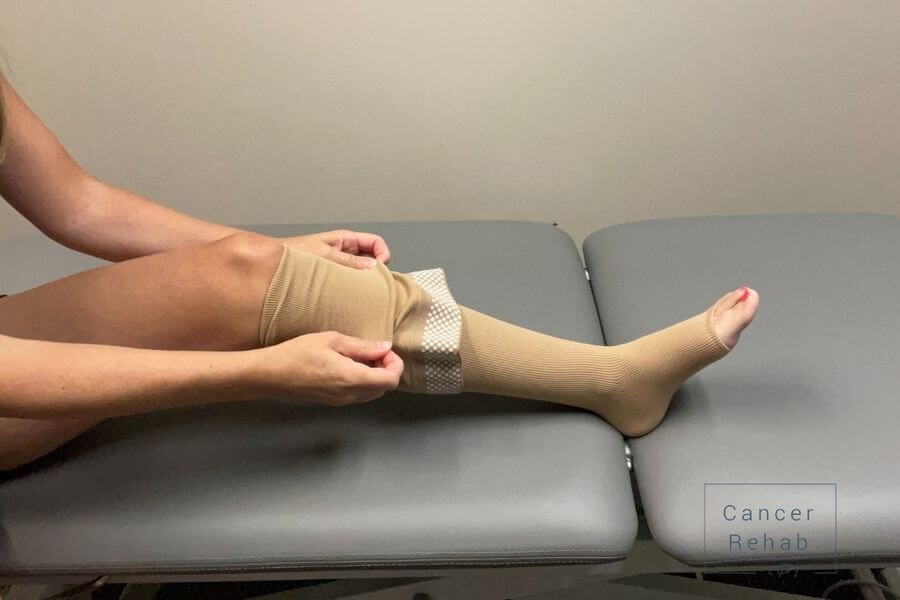
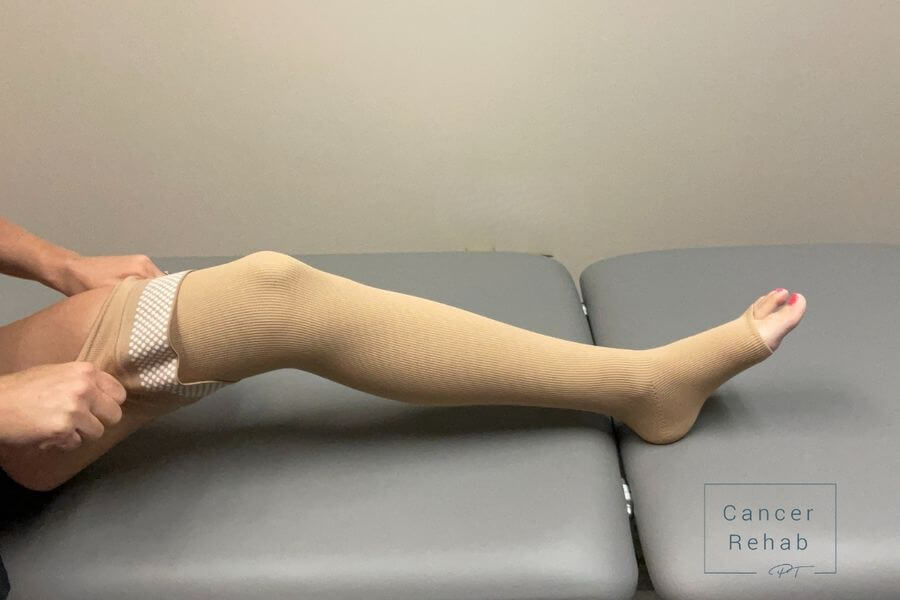

Step 7: Position the Top Band Correctly
- The silicone grip band should sit comfortably on your thigh
- It should be snug but not cutting into your skin
- Smooth out any wrinkles in the thigh area
- Make sure the stocking isn’t twisted
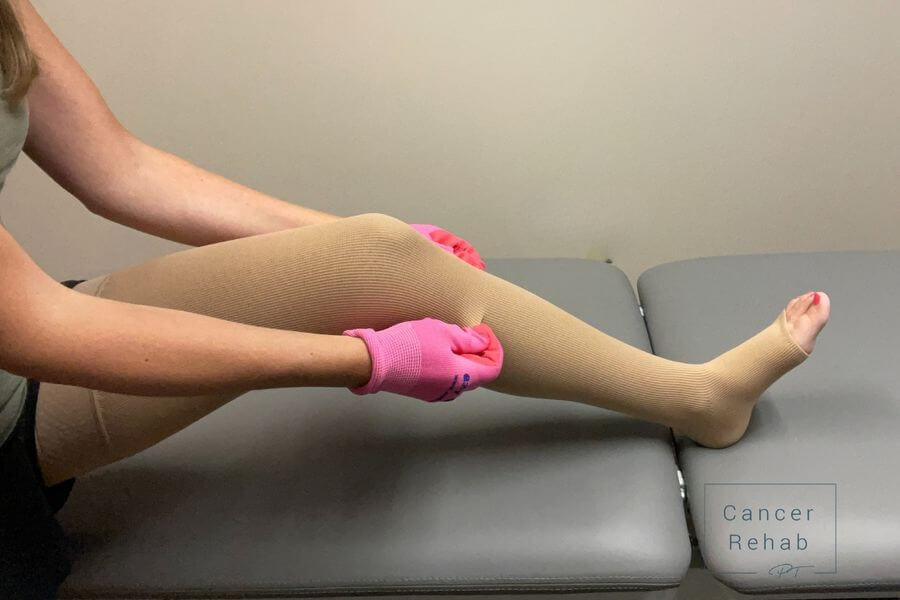
Important Note for Thigh-High Stockings: These require significantly more effort and time. Don’t rush the process, and consider using donning aids (discussed below) if you have any limitations with reaching or hand strength.
How to Take Compression Socks Off Properly
A lot easier than the other ways! To get it off, instead of bunching it down (which is going to make it really tight again to get it over the heel), what you want to do instead – again, minimal layering – so I’m going to fold it over, pull it down as far as I can, and then I’ll go back and work the rest off in sections.
I have had some patients show me how they use grip-enhancers (shared below) to slide their heel on to help or other similar ways.
Additional Grip and Sliding Aids for Easier Application
Beyond the major donning aids I share later in this blog, there are several smaller accessories that can make learning how to put on compression socks much easier:
Donning Gloves – Multiple Options
Price Range: $15-30
How They Work: Anything that has a little bit of a grip to it can allow for those who have trouble with gripping to wear those and help pull up the stocking.
I recommend several types:
- Specialized donning gloves: Made by brands who make compression stockings specifically
- Gardening gloves: That have some grip to it
- Rubber gloves: That we would use for washing dishes or something like cleaning
You would do the same sort of technique that I just showed, but instead when you pull up or pull on, you can wear your gloves to help pinch and grip and pull the stocking up. From there when you’re trying to smooth out the creases, the glove is really nice with the grip to help with that – you can help pull some of the fabric back down or pull it up depending on what you need to do to adjust.
Grip-Enhancing Aids:
Dycem
Price Range: $15-25
How It Works: This is a little bit sticky and it does a really nice job of gripping to some sort of surface.
Dycem is great to help slide a sock up or down to help move tight fabric and smooth out creases. The other thing you can do for those who have Dycem is you can put it on the ground, and from there you can try putting your stocking on in one big pull if you feel you can get a lot of fabric up.
Juzo Easy Pad
Price Range: $18-$25
How It Works: A textured pad that provides grip and helps guide the garment up your leg.
The Juzo Easy Pad is particularly helpful for people who find it difficult to grip the fabric and pull it up (or down) over the heel. You can put it on the ground and dig your heel into it to help move the stocking without your hands.
When Reaching Your Feet or Legs Is Challenging
I want to address something that many of my patients face but rarely talk about openly: what happens when you physically cannot reach your feet or legs comfortably? Whether due to recent surgery, joint limitations, pregnancy, back conditions, or changes in mobility, many people find themselves in situations where the standard advice doesn’t apply to them.
You are not alone in this challenge, and there are absolutely solutions that can help you maintain your independence with compression therapy.
Donning Aids: Your Best Solution for Limited Reach
When bending, stretching, or reaching is difficult or impossible, frame-style donning aids become essential tools rather than convenience items. These devices are specifically designed to eliminate the need to bend down or reach your feet. There are also options that help take strain off of the hands for those who have issues with grip.
When You Need Extra Help: Popular Donning Aid for Compression Socks
Sometimes, even with perfect technique, you need additional assistance. This is especially true if you have arthritis, limited mobility, or are dealing with higher compression levels. Here are the donning aid for compression socks options I recommend most often to my patients:
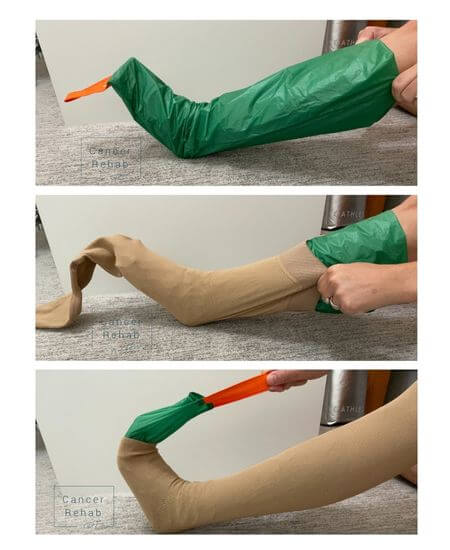
Arion Easy-Slide
⭐⭐⭐⭐⭐
Best for Open-Toe Stockings
💲 Price Range: $30-45
⚖️ Best For: Open-toe stockings and pulling stockings over the foot and heel
⭐ How It Works:
This fabric sleeve creates a smooth surface that reduces friction between your skin and the compression garment.
I recommend these green or clear slides for those who can just pull up the garment, have no issues with the pulling, but again have trouble with the heel area or just have trouble because maybe they put lotion on or their skin’s a little sticky from the humidity and the stockings have a hard time going up against that skin.
Pros: Long-lasting, washable, easy to fold and transport
Cons: Only works with open-toe stockings, need strength and leverage to pull the handle down by the foot
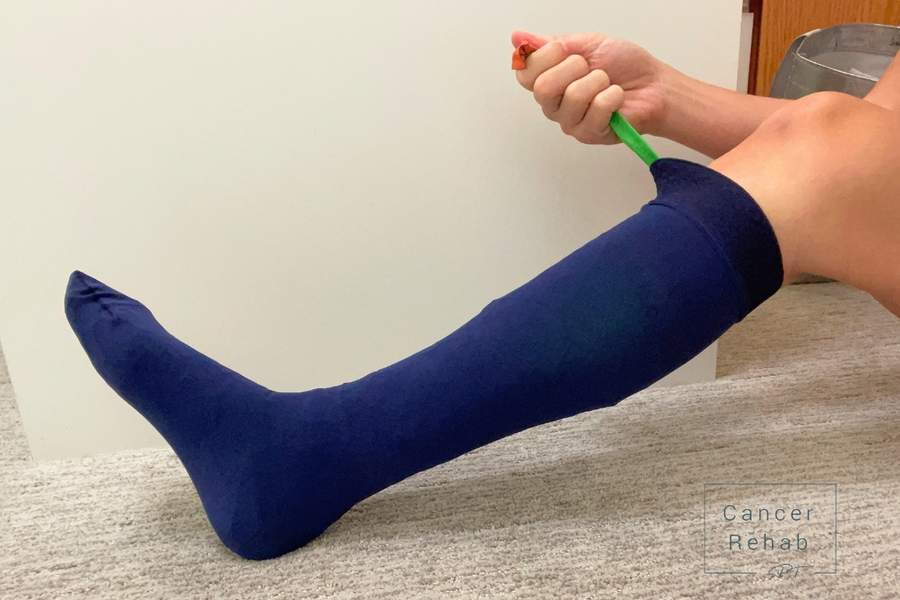
Arion Magnide
⭐⭐⭐⭐⭐
Best for Closed-Toe Stockings
💲 Price Range: $50-65
⚖️ Best For: People who prefer closed-toe stockings, patients with fluctuating swelling
⭐ How It Works:
Uses a magnetic system combined with sliding properties to help load closed-toe garments.
The Magnide is a version of the easy slide for stockings and tights with closed toes. It has flexible sizing to fit different limb sizes, which is particularly important for patients with swelling that varies throughout the day.
Pros: Long-lasting, washable, easy to fold and transport
Cons: Only works with open-toe stockings, need strength and leverage to pull the handle down by the foot
Medi Butler
⭐⭐⭐⭐⭐
Best for People who have trouble bending at the waist
💲 Price Range: $30-80 (depending on the model)
⚖️ Best For: People who have trouble bending at the waist and need durability
⭐ How It Works:
Metal frame that holds the stocking open while you step into it, then pull up using handles.
The Medi Butler line includes several options:
Medi Panty Butler Donner: For those using compression tights or pants
Medi Assure Butler: Most economical option with 4″ opening
Medi Big Butler: 6″ opening for larger legs, 18″ height – longer handles for those who can’t bend down as far
Pros: Excellent for people with back problems or who have issues bending over, various sizes available, durable
Cons: Bulky to store, takes practice to load stocking correctly, not flexible if one fluctuates in size
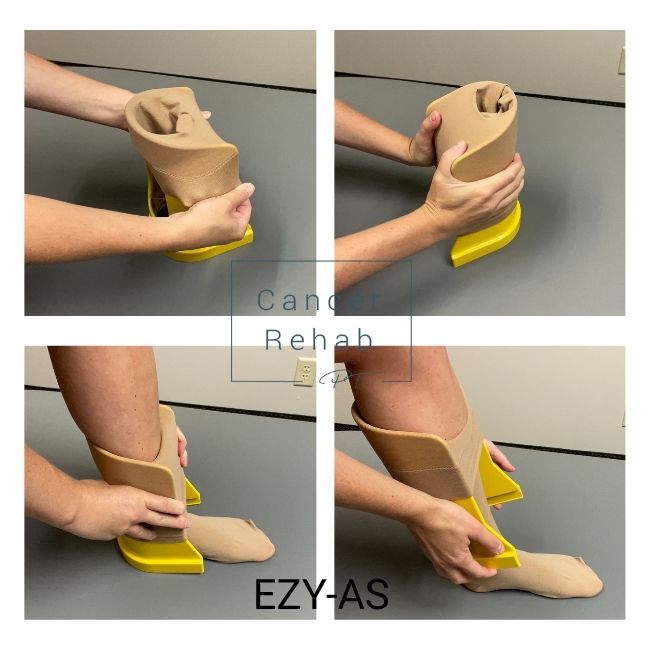
EZY-AS Applicator
⭐⭐⭐⭐⭐
Best for Both arms and legs
💲 Price Range: $40-60
⚖️ Best For: Both arms and legs, various compression levels
⭐ How It Works:
Rigid plastic frame that doesn’t collapse, available in multiple sizes.
A simple donner that the sock is applied to by hand, then one can step or slide the foot into the garment and slide the EZY-AS applicator up with ease.
Pros: Works on arms and legs, very sturdy, stands independently, available in multiple
Cons: Extender handles available separately, need to measure carefully for correct size

*Note that there is an EZY-As Applicator Handle sold separately
Doff N’ Donner
⭐⭐⭐⭐⭐
Best for Those without strong grip strength or ability to pull
💲 Price Range: $60-70 for Rolly and $50-$55 for Cone
⚖️ Best For: Those without strong grip strength or ability to pull, as well as getting compression stockings off
⭐ How It Works:
The Rolly and Cone (sold separately) work to roll the garment on or off the leg.
I love this option for those who struggle with grip strength or the ability to pull. It’s very easy to use, the only downside is that someone will need to be able to bend over to reach the foot to use it.
Pros: Flexible, unique design that requires minimal effort from you hands, used for getting stocking on and off
Cons: Rolly and Cone are sold separately, must be able to bend down to reach foot
Choosing the Right Donning Aid for Compression Socks
After working with hundreds of patients, here’s a few helpful tips:
If you have limited mobility or back problems: Start with a Medi Butler or EZY-AS with handle attachment.
If you can bend but need better grip: Donning gloves or the Doff N’ Donner are both helpful.
If you wear open-toe stockings: The Arion Easy-Slide is one of the easiest options.
If you wear closed-toe stockings: The Arion Magnide, EZY-AS, or Medi Butler are all great options.
If you have fluctuating swelling: Look for aids with flexible sizing like the Magnide or you’ll need multiple sizes of the EZY-AS.
If you want help taking the garment on and off: The Doff N’ Donner and Juzo Easy Pad are helpful to lessen strain on the hands.
When to Ask for Professional Help
Sometimes, despite your best efforts, you need additional support. Consider reaching out to a healthcare professional if:
- You consistently can’t get your compression wear on
- You’re developing skin irritation or pressure sores
- Your swelling has changed significantly
- You’re avoiding wearing your compression because it’s too difficult
As a lymphedema therapist, I often work with patients on proper fitting and technique. Finding a DME vendor in your area can also be incredibly beneficial.
The Bottom Line: Mastering How to Put On Compression Socks
After seeing thousands of patients master how to put on compression socks, I can tell you with confidence: if you’re struggling, there ARE ways to try and help make this manageable. I know it’s not easy- even with all the tools.
Remember, compression therapy only works if you actually wear your garments. They can help to improve blood flow, varicose veins, and lymphatics. Don’t let the difficulty of putting them on prevent you from getting the lymphatic and circulation support you need.
Looking for a video to watch? Check out my video here:
Frequently Asked Questions About How to Put On Compression Socks
Should compression socks be hard to put on?
Donning compression stockings should require more effort than regular socks, but they shouldn’t be extremely difficult or painful to put on. If you’re struggling significantly, it could mean the socks are too small, you need a different compression level, or you haven’t learned the proper technique yet.
Start with a lower compression level (15-20 mmHg) or try using a donning aid for ease. Remember, the tight compression that gives you so many physical benefits can be a bit of a struggle if you don’t know the correct way to slip on your compression socks, but with the right technique, it becomes much easier.
When should I put on compression socks – morning or night?
The best time to put on compression socks is first thing in the morning before any swelling occurs. Your legs are typically at their smallest circumference when you first wake up, making the socks easier to apply. If you wait until later in the day when swelling has developed, you’ll find them much more difficult to put on.
How do I know if my compression socks are too tight?
Compression socks should feel snug and supportive, but not painful. Signs that your compression socks may be too tight include:
- Numbness or tingling in your toes
- Skin that turns blue or white
- Increased pain or discomfort
- Red marks or indentations that remain after 30 minutes
- Difficulty putting them on even with proper technique
If you experience any of these symptoms, consult with your healthcare provider about getting properly fitted for the right size and compression level.
How long should I wear compression socks each day?
Most people wear compression socks for at least a few hours a day, but this can vary depending on your individual needs. For medical conditions like lymphedema or chronic venous insufficiency, you may need to wear them all day. For general wellness, travel or to support blood flow, you might only wear them during specific activities.
They may also be worn temporarily for conditions like blood clots or DVTs.
Always follow your healthcare provider’s recommendations for wear time. Generally, it’s safe to wear properly fitted compression socks during your waking hours and remove them before bed.
Can I sleep in compression socks?
Unless specifically recommended by your healthcare provider, you typically shouldn’t sleep in compression socks. Your legs are elevated when lying down, which naturally helps with circulation and reduces swelling. The additional compression during sleep is usually unnecessary and could potentially cause discomfort or tourniquets.
However, there are some medical conditions where nighttime compression may be recommended. Always consult with your healthcare provider about the appropriate wear schedule for your specific situation.

